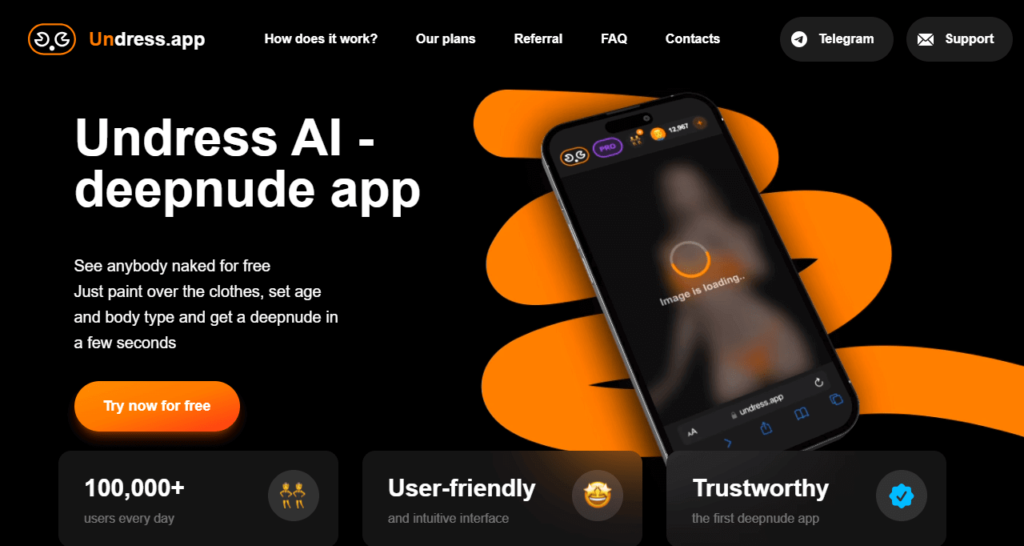In an era where technology pervades nearly every aspect of our lives, the intersection of digital innovation and personal privacy often raises eyebrows. One such instance is the emergence of “undress apps,” which promise users the ability to digitally remove clothing from images of individuals. While these apps may appear innocuous at first glance, they bring forth a host of ethical concerns and potential risks that warrant closer examination.
Undress apps, typically powered by sophisticated image-processing algorithms, claim to use artificial intelligence to “undress” individuals in photos, revealing what lies beneath their clothing. Marketed with catchy slogans and promises of entertainment or amusement, these apps have garnered attention from curious users intrigued by the notion of altering images in such a manner.
However, beneath the surface allure lies a myriad of ethical dilemmas. Firstly, there’s the issue of consent. In many cases, the subjects of these digitally altered images have not given explicit permission for their photos to be manipulated in such a manner. This raises serious questions about the infringement of personal privacy and the potential for exploitation, particularly in the age of deepfakes and non-consensual image sharing.
Moreover, the proliferation of undress apps fuels objectification and contributes to a culture of voyeurism and disrespect for personal boundaries. By reducing individuals to mere objects of entertainment or titillation, these apps perpetuate harmful stereotypes and undermine efforts towards gender equality and respect for bodily autonomy.
Beyond ethical concerns, undress apps also pose significant risks in terms of cybersecurity and online safety. The process of using such apps often involves uploading personal photos to third-party servers, raising the specter of data breaches and unauthorized access to sensitive information. Users may unwittingly expose themselves to exploitation or blackmail, particularly if the images in question are intimate or compromising in nature.
Furthermore, the normalization of undress apps can have detrimental effects on societal attitudes towards consent and privacy. By trivializing the act of digitally altering someone’s appearance without their consent, these apps contribute to a culture of entitlement and disregard for boundaries, both online and offline.
In response to these concerns, some jurisdictions have taken steps to regulate the use and dissemination of undress apps, emphasizing the importance of consent and privacy in the digital age. However, enforcement mechanisms remain limited, and the global nature of the internet poses challenges in terms of jurisdictional authority and oversight.
Ultimately, the proliferation of undress apps underscores the need for a broader conversation about ethics, technology, and the boundaries of personal privacy. As we navigate the complexities of the digital landscape, it is imperative that we remain vigilant against the normalization of harmful practices and strive to uphold principles of respect, consent, and dignity for all individuals, both online and off.
Frequently Asked Questions About Undress Apps
1. What is an undress app?
An undress app is a mobile application or software that utilizes image-processing algorithms, often powered by artificial intelligence, to digitally remove clothing from individuals in photos. These apps alter the appearance of the subjects by simulating nudity, creating the illusion of undressed individuals.
Also Read: Unveiling the LiveJasmin Phishing Virus: Protecting Yourself in the Online Wilderness
2. How do undress apps work?
Undress apps typically function by analyzing the pixels of an image and identifying areas corresponding to clothing. Advanced algorithms then manipulate these areas to simulate the removal of clothing, revealing what lies beneath. Some apps may use machine learning techniques to improve accuracy and realism over time.
3. Are undress apps ethical?
The ethics of undress apps are widely debated. Many argue that these apps violate the privacy and dignity of individuals depicted in photos, particularly if used without their consent. Moreover, undress apps can perpetuate harmful stereotypes and contribute to a culture of objectification and voyeurism.
4. Are undress apps legal?
The legality of undress apps varies depending on jurisdiction and context. In some regions, the use of such apps may constitute a violation of privacy laws or regulations governing digital manipulation of images. Additionally, distributing sexually explicit content without consent may be subject to legal repercussions.
5. Are undress apps safe to use?
Using undress apps can pose risks to personal privacy and cybersecurity. Uploading personal photos to third-party servers for processing raises concerns about data security and the potential for unauthorized access. Furthermore, users may inadvertently expose themselves to exploitation or blackmail if images are intimate or compromising.
6. Can undress apps be used for non-consensual purposes?
Yes, undress apps have the potential to be used for non-consensual purposes, such as creating fake nude images of individuals without their knowledge or consent. This practice, known as “deepfake” manipulation, raises serious ethical and legal concerns and may constitute a form of harassment or abuse.
7. What measures can be taken to mitigate the risks associated with undress apps?
To mitigate risks associated with undress apps, users should exercise caution when downloading and using such apps, particularly regarding the uploading of personal photos. It is essential to read and understand the app’s privacy policy and terms of service, as well as to employ strong security measures, such as using reputable apps and platforms and avoiding sharing sensitive images online.
8. Are there regulations governing undress apps?
Regulations governing undress apps vary by jurisdiction, and enforcement mechanisms may be limited. Some regions have implemented laws or guidelines addressing the digital manipulation of images and the protection of personal privacy online. However, the global nature of the internet poses challenges in terms of enforcement and oversight.

